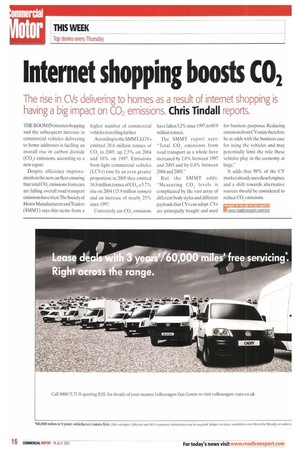Internet shopping boosts CO2
Page 16

If you've noticed an error in this article please click here to report it so we can fix it.
The rise in CVs delivering to homes as a result of internet shopping is
having a big impact on CO2 emissions. Chris Tindall reports.
THE BOOM IN internct shopping and the subsequent increase in commercial vehicles delivering to home addresses is fuelling an overall rise in carbon dioxide (CO2) emissions, according to a new report.
Despite efficiency improvements in the new car fleet ensuring that total CO, emissions from cars are falling, overall road transport emissions have risen.The Society of Motor Manufacturers andTraders (SMMT) says this stems from a higher number of commercial vehicles travelling further According to the SMMT. LGVs emitted 28.6 million tonnes of CO2 in 2005, up 2.5% on 2004 and 10% on 1997. Emissions from light commercial vehicles (LCVs) rose by an even greater proportion: in 2005 they emitted 16.8 million tonnes of CO2, a 5.7% rise on 2004 (15.9 million tonnes) and an increase of nearly 25% since 1997.
Conversely, car CO2 emissions have fallen 3.2% since 1997,to 69.9 million tonnes.
The SMMT report says: "Total CO2 emissions from road transport as a whole have increased by 2.8% between 1997 and 2005 and by 0.4% between 2004 and 2005."
But the SMMT adds: "Measuring CO2 levels is complicated by the vast array of different body styles and different payloads that CVs can adopt. CVs are principally bought and used for business purposes. Reducing emissions from CVs may therefore be at odds with the business ease for using the vehicles and may potentially limit the role these vehicles play in the economy at large."
It adds that 99% of the CV market already uses diesel engines, and a shift towards alternative sources should he considered to reduce CO, emissions.


























































































































































































